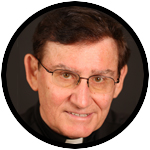
Father Eugene Hemrick
“It ruined me for life.”
This utterance is that of a participant in lay volunteerism. Disturbing images of working with the poor in a foreign country were burned into his memory — images of the gap between rich and poor that drive him to continue to serve the poor back at home.
Students at St. Vincent College in Latrobe, Pennsylvania, who worked with people living off dumped garbage in Guatemala, also reported they would never be the same because of the images left by that experience.
In a keynote address at a recent J.S. Paluch gathering of vocation directors, Bishop Frank J. Caggiano noted we now live in a digital world of images that possesses the power to move young people as never before — a world to take most seriously.
[hotblock]
New imaging raises challenging questions for today’s church: If the advancement of imaging is now a leading tool for moving people, what would happen if the church applied the best of imaging in attracting more priests, deacons and lay ministers? This doesn’t imply that the church isn’t doing a good job, but asks, Is the church doing enough?
For example, how much diligent scientific research goes into learning why one image moves a person more than another? In promoting the priesthood, is the image of priests in collars praying more, less or equally powerful than portraying priestly ministry like being a military chaplain, campus minister, ministering to a dying person or being involved in social justice issues?
What role does the setting of an image play? Is the image of a deacon with sleeves rolled up helping a poor person to find a job more, less or as attractive as a deacon preaching or baptizing?
When lay ministry is portrayed, is it portrayed by one person’s work or a team of persons in consultation?
How often are those aspiring to minister put into an actual situation — as were the people working with the poor cited here? Is setting up real situations used, when possible, to create moving images?
As powerful as is the written word, the role of imaging is now equal to and in many places surpassing it: an advanced art and skill for making church progress.
PREVIOUS: A layperson to church leaders: You have let us down!
NEXT: Leaving the church is not the answer to clerical scandals



Share this story